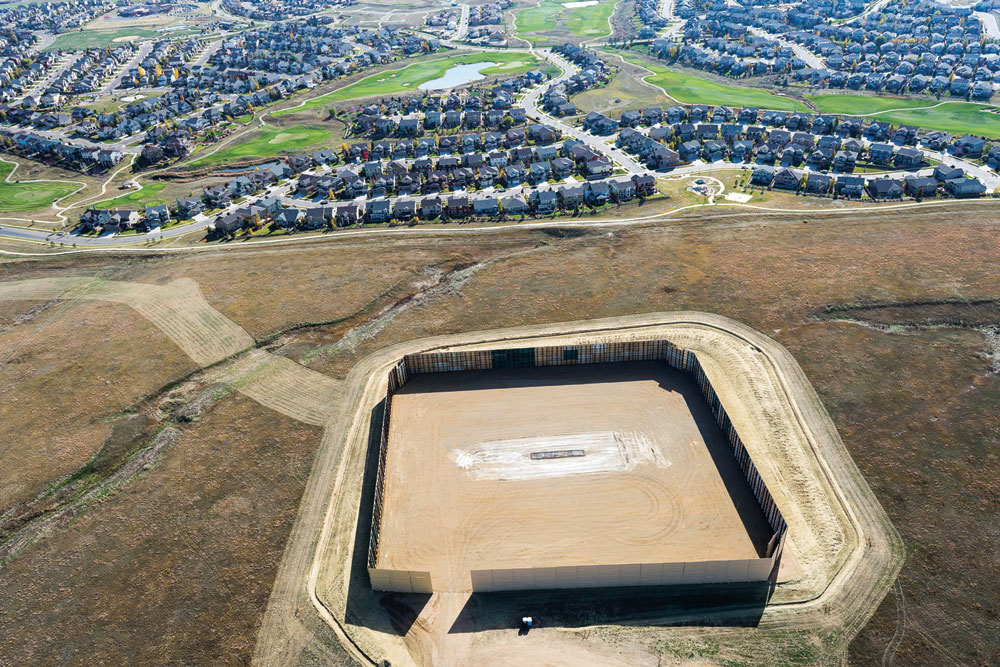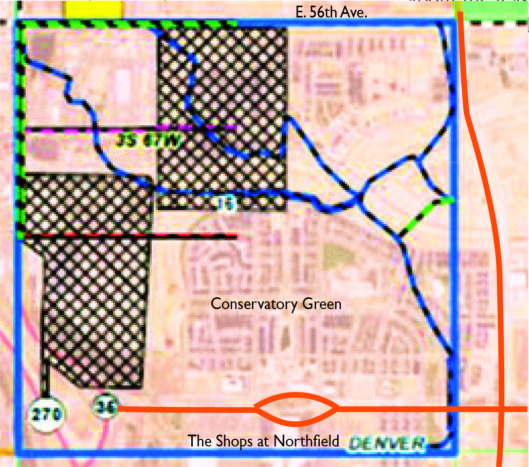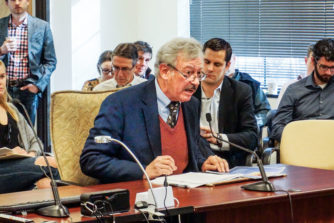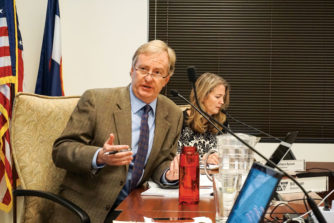
This aerial photo shows a well pad being constructed near a housing subdivision in Erie, Colorado, with a wall shielding it from view. A temporary access road is on the left. Photo by Evan Anderman
Mineral rights under Stapleton land were nearly made available for auction last month, which would have allowed oil and gas operators to bid for the right to drill. By a 4-0 vote, influenced by public comment, the State Land Board rejected the idea, but what is going on?
For residents, the turmoil began with a neighborly posting on Facebook. Nick Kaczor, the assistant manager of the Rocky Mountain Arsenal National Wildlife Refuge (“Refuge”), began his Jan. 16 post with, “Don’t shoot the messenger…” attached to a map and a link to a proposal before the Colorado State Land Board (“SLB”) for its Jan. 18 meeting.
Retired Lone Tree geologist, Ron Pritchett, had nominated for auction the oil and gas drilling rights underneath four parcels of land whose mineral rights are controlled by the SLB. One of these tracts includes the north Stapleton neighborhoods of Conservatory Green and Willow Park, as well as part of the Northfield shopping area. One of the other parcels is in the center of the Refuge, another in Commerce City and the last in the Green Valley Ranch area.
The Refuge is the prize in Pritchett’s plan, which he provided to The Front Porch and is available on our website. In it, he proposes accessing what he estimates could be a play of 170 million Barrel of Oil Equivalents (BOEs) under and adjacent to the Refuge’s federal lands. These would be accessed via horizontal drilling, with surface wells that could be located two to three miles from the rights they are mining.
Just prior to the Jan. 18 SLB meeting, the parcel in the center of the Refuge was removed from consideration due to a pre-existing agreement with the Dept. of the Army that precluded the SLB from developing those rights. But the other three remained.
Section 16 Proposed Drilling Lease Area

This map shows the boundaries of the Stapleton tract whose mineral rights were nominated for auction. The checkered areas were excluded from consideration due to long-term non-development leases, but the remaining areas include most of Conservatory Green and Willow Park East and parts of The Shops at Northfield.
Community Response
Kaczor’s Facebook post set off a firestorm in Stapleton. It was re-posted across social media, and residents inundated the SLB with phone calls and over 450 emails, urging the commissioners to reject the proposal, which was coming to vote a mere two days after the Facebook notification. Many community members showed up at the SLB meeting, and three of them commented on the proposal.
“I can’t help but feel that there’s a hypocrisy where we’re talking about a wildlife refuge and a land conservancy where human beings are not allowed yet oil and gas drilling is,” said Conservatory Green resident, John McCollins. “That is the ultimate hypocrisy in my mind.”
He was joined in opposition by John Blegen, who noted that the Stapleton parcel is occupied by 1,700 homes and 5,500 people. Blegen also recounted how, when the Army Corps of Engineers occupied the Refuge, they “attempted to drill a well to pump down their hazardous materials, which sounds to me a lot like fracking, and created a series of seismic events, up to a 5.3 earthquake.”
Kiersten Williams, OB/GYN, shared with the board her concerns about studies that have shown an increase in birth defects in areas where drilling has occurred and also noted that she had heard stories about seismic events related to drilling in the Refuge area.

Lone Tree geologist, Ron Pritchett, described the benefits of horizontally drilling underneath land in Stapleton and adjoining areas to the Colorado State Land Board (SLB) commissioners. Proceeds from the mineral rights would go to trusts that benefit public schools.
Local Representation
In addition to the Stapleton residents, a representative from Commerce City spoke on behalf of the city’s interests. Michelle Halsted stated that Commerce City was not supportive of surface occupancy in dense residential areas and asked, if the SLB were to approve the lease rights, that they stipulate against surface occupancy and that the lessee would have to follow local oil and gas regulations.
The presence of Commerce City’s representative, as well as written comments that had been submitted by Denver Water and Refuge staff, highlighted the absence of Denver city and county representatives at the meeting.
According to the SLB, in November they had notified Francisco Alonzo, the Colorado Oil and Gas Conservation Commission’s (COGCC) Local Government Designee (LGD) for Denver about the proposed auction. Attempts by The Front Porch to contact Alonzo, the Director of Commercial Affairs at Denver International airport, were fruitless; it is unclear who, if anyone, Alonzo notified about the proposal.
The Mayor’s office said only that they were notified “late in the process,” but that they had contacted the governor’s office and members of the state legislature. The Mayor’s office said, going forward, the City Attorney would be the designated point of contact for future SLB auctions.
The Outcome, for Now
The staff at the SLB had recommended that its board approve the auction of the mineral rights under these urban parcels. At the meeting, staff explained that the auction of the rights was just the first step in a very long process and that only about one in ten rights actually get developed, usually after five or six years of a long process of approval.
But despite staff recommendations, the public outcry against the nomination appeared to sway the board, which voted 4-0 to reject the proposal to bring the rights to auction. “I really am concerned about the risk/reward in this type of property…it is important to listen to the public,” said Commissioner John Shaw. “The obstacles towards actually realizing any development on all of these properties…seems so [significant] that greenlighting this first process doesn’t even seem to get anyone any closer,” said Commissioner Barbara Bynum. “We are not in a worse position by holding off and seeing if other mineral owners want to stick their necks out…”
The board’s vote means that the tracts cannot be nominated again for one year.
The Future
The auction of SLB mineral rights under land in Stapleton, Commerce City and Green Valley Ranch has been deferred for at least a year and, in the case of the SLB parcel at the Refuge, indefinitely. If the tracts are nominated again, all documentation regarding why they were declined would be reviewed and presented to the board. And presumably, if any tracts in Denver are nominated, the notification to the new LGD, the City Attorney, would result in more prompt notification of local government representatives. At that point, the issue of city and county regulations and citizen input would become important.

State Land Board director Bill Ryan explains the history and mission of the organization. SLB staff recommended the approval of Pritchett’s nomination to auction leases to mineral rights underneath three tracts adjacent to the Rocky Mountain Arsenal National Wildlife Refuge, including one in north Stapleton.
But the full proposal by the geologist, Pritchett, has other potential implications, because his proposal for the four tracts described above is just the tip of an iceberg.
Pritchett’s proposal suggests that the reserves under and adjacent to the Refuge could be tapped from 22 well sites constructed on Refuge property. These well pads would ring its perimeter so as to horizontally drill for oil and gas from both inside the Refuge and from underneath adjacent lands. Pritchett estimates this play could yield 170 million BOEs. With oil at $65/BOE and natural gas at $17/BOE the incentive to drill is considerable. Royalties to mineral rights holders are typically around 12.5%.
The Refuge enjoys federal protection as a wildlife preserve, so siting wells on it is currently unlikely, but Department of Interior Secretary Ryan Zinke has expressed enthusiastic support for onshore drilling on federal lands. The mineral rights of land adjacent to the Refuge are privately held, including the rights underneath Sections 9 and 10, where Dick’s Sporting Goods Park and the Beeler Park neighborhood are located. Private owners can presumably decide whether to lease or sell without public input.
Experts believe that it is unlikely that an oil and gas operator would be interested in drilling on the Refuge or adjacent populated neighborhoods due to political, legal and regulatory considerations. Stay tuned for more information in the coming months as we investigate this story and talk with local representatives and experts about the feasibility of drilling in our neighborhood.
_____________________________
What is the Colorado State Land Board?
“The Land Board was created in 1876 as a condition of statehood,” explained SLB director, Bill Ryan. “When Colorado petitioned to become a state, the Federal Government said ‘we’re going to grant you the land for your state, but section 16 and section 36 of every township is going to go into a trust to benefit the common schools.’” According to Ryan, “This concept of land being used to support the schools really dates back to the founding of the country. The founding fathers thought that the key to a stable democracy was going to be an educated citizenry.”
The SLB is the second-largest landowner in Colorado, with 2.8 million surface acres and 4.0 million mineral estate acres in over 60 counties. The SLB can sell or lease surface rights but can only lease the underlying mineral rights. It does not operate businesses, instead selling or leasing the lands that are held in eight public land trusts for the benefit of public schools and institutions.
According to its website, “A dual mission guides State Land Board management of these assets: to produce reasonable and consistent income over time, and to provide sound stewardship of the state trust assets.” The SLB’s commissioners are appointed by the governor.
Mineral Rights
Surface areas of land can be owned separately from the minerals underneath. According to mineralweb.com, in parts of the U.S., “where drilling, mining or wind energy operations are common, it is not unusual to see ownership rights that are segregated (i.e., severed).” Colorado is one of the states where it is common for minerals —the “mineral estate”—to be severed from the surface estate.
Usually, surface rights are subservient or secondary to mineral rights, so an oil and gas company that owns or leases the mineral rights can use the surface land to access them. The Colorado Oil & Gas Conservation Commission (COGCC) has information on its website about Colorado regulations.




Dear Mr. Netz,
The following report by David Evans (1966) describes why the Rocky Mountain Arsenal injection well caused earthquakes. You will see in these details: fluids were injected into crystalline basement rocks, not overlying sediments; where fluid was placed and added made the difference. Oil and gas operations on the Rocky Mountain Arsenal lands would subtract pressures and fluids within the sedimentary layer, 1 1/2 miles below the surface and thousands of feet above the crystalline basement. Yes microseisms would be created in drilling operations and hydraulic fracturing – comparable to the seismicity of truck traffic on I-70 or a coal-train passing through town – though it is unlikely that a tremor would be created that would damage buildings at the surface. Evidence includes: common hydraulic fracturing operations in the Greater Wattenberg Field that do not result in property-damaging earthquakes. Thank you for your interest and awareness of potential problems – you can be sure that pressures and seismic events would be monitored and controlled for seismic safety – and no engineer wants to be associated with operations that create seismic damage.
https://scits.stanford.edu/sites/default/files/evans_0.pdf
A retrospective analysis of the earthquakes caused in the ’60s by pumping waste by the Army Corps of Engineers would make an interesting article and would highlight why this is not an appropriate location.
Thank you, Melinda Pearson for your reporting work, and I thank the staff and Commissioners at the State Land Board for considering the proposal. Those who review the report can assess why it is reasonable to model recovery of potential resources with modern methods, from facilities on Arsenal land located more than one mile north and through a well bore located more than one mile below houses and potable water aquifers. Daily, the petroleum industry safely delivers petroleum resources via similar production practices for the benefit of Colorado citizens, demonstrated in operations throughout the Greater Wattenberg Field adjacent to the Rocky Mountain Arsenal land.
Regarding the earthquakes in the 60s. The drilling for oil and gas nor the perforation of rocks below the surface, more commonly referred to as “fracking” is believed by scientists to cause earthquakes. Fracking in essence shatters the rock formations using typically large amounts of water, petroleum jelly and sand, some 8,000-14,000′ below the surface. This technique releases pressure. However, there is a large amount of evidence mounting that lead scientists to believe wastewater disposal, (SWD) wells are likely responsible for inducing earthquakes. When large amounts of fluid is pumped into a reservoir in the ground, pressure is built. Some believe earthquakes are a byproduct of the pressure releasing. This sounds consistent with the earthquakes experienced after the Corp of Engineers attempted to dispose of hazardous materials underground in the 60s.
https://stateimpact.npr.org/oklahoma/tag/earthquakes/
The fracturing of rocks to increase the productivity of oil and gas wells is an old technique which has been around since the 1950s. The only difference is now instead of drilling multiple vertical wells, which creates a larger human impact on the environment, horizontal drilling allows one well to drain an area much larger, in addition to accessing reserves stored in the rock miles below the ground which previously weren’t accessible. The process is highly regulated, monitored and generally safe.
That being said, there are issues that can arise from the way companies store their wasted materials. In certain states, drilling mud which consists of all types of chemicals and other fluids is sometimes buried and stored on location, “wellpad” in holes filled with a protective liner. Generally these liners are safe. However, there have been instances where these liners have been damaged or cut, causing leaks which could potentially lead to the contamination of groundwater. If drilling is allowed in the area, we need to make sure cutting pits are not allowed on location and disposal of produced water is stored far away off location. Preferably in TX or California:) JK
Obviously fossil fuels are a necessity. They allow you to power and heat your house, fuel your car and type angry responses to this thread via your cell phone or computer. In my opinion it is better to develop our own resources RESPONSABLY, provide jobs and generate revenue for our schools and govt. programs, as opposed to sending our money overseas.
Respectfully,
Jim Dandy